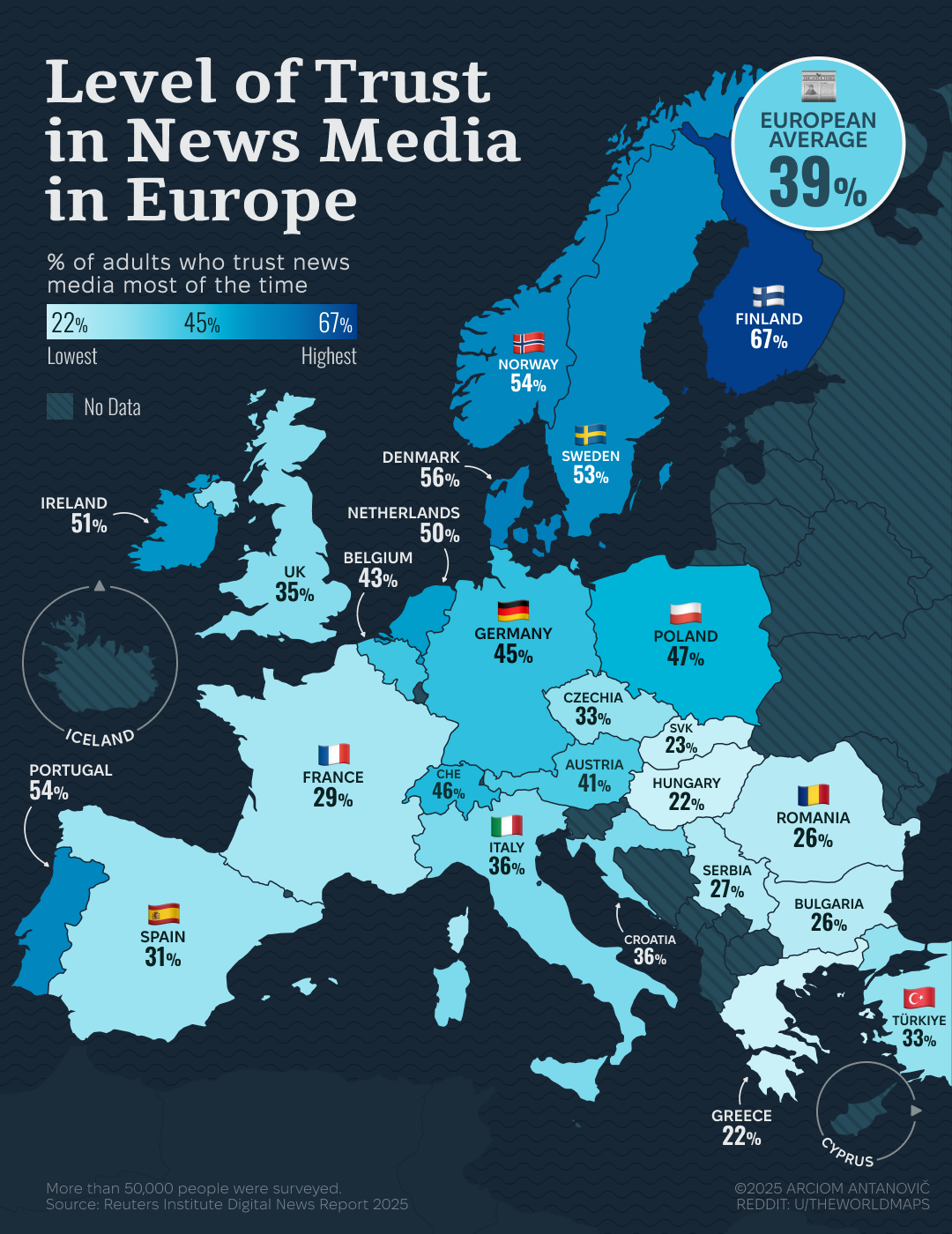Trust in News Media by Country Map


Marcus Rodriguez
Historical Geography Expert
Marcus Rodriguez specializes in historical cartography and geographic data analysis. With a background in both history and geography, he brings unique...
Geographic Analysis
What This Map Shows
The "Level of Trust in News Media in European Countries" map provides a visual representation of how citizens across Europe perceive the credibility and reliability of their news sources. This visualization highlights the varying degrees of trust that different nations place in their media outlets, offering a compelling snapshot of the public's confidence in journalism. In a time where misinformation spreads rapidly and the media landscape evolves continuously, understanding these trust levels is crucial for both media professionals and the public.
Deep Dive into Trust in News Media
Trust in news media is a critical component of a functioning democracy and an informed citizenry. It reflects the relationship between the public and the information provided by journalists. In Europe, the level of trust in news media varies significantly from country to country, influenced by factors such as historical context, media ownership, regulatory frameworks, and the state of democracy.
Interestingly, countries like Finland and Norway consistently top the trust charts, with over 70% of citizens expressing confidence in their news media. This high level of trust can be attributed to a combination of factors, including robust public service broadcasting systems, stringent journalistic standards, and a commitment to transparency.
On the other hand, nations such as Hungary and Poland have reported much lower trust levels, often below 40%. These declines can be linked to government influence over media outlets, leading to concerns about propaganda and biased reporting. The trend in these countries raises alarms about the implications for democracy and public discourse.
Moreover, the rise of social media as a primary news source has further complicated the trust dynamics. Many people find themselves caught in a web of fake news and echo chambers, which can distort their perception of credible journalism. In countries like the United Kingdom and France, where trust in traditional media is on the decline, a significant portion of the population turns to social platforms for news. This shift has sparked debates about the responsibilities of both media companies and social media platforms in combating misinformation.
Statistics show that in countries with high trust levels, like Denmark, the media landscape is characterized by diverse ownership and a plethora of independent outlets, fostering a competitive environment that encourages quality journalism. In contrast, countries with lower trust often have media monopolies or oligopolies, which can stifle dissenting voices and lead to a homogenization of viewpoints.
Regional Analysis
When examining the map closely, we notice distinct regional patterns in media trust. Northern European countries generally show higher levels of trust, with citizens often viewing their news media as reliable and objective. For instance, Sweden and Denmark have fortified their media sectors with government support and a cultural emphasis on journalistic integrity.
In Southern Europe, the picture is more mixed. Spain and Italy have moderate levels of trust, hovering around the 50% mark. Historically, these countries have faced challenges such as political corruption and economic instability, which have influenced public perception of media reliability. Conversely, Greece has reported some of the lowest trust levels in Europe, attributed to years of economic crisis and a perception of media bias.
Eastern Europe presents a stark contrast to the West. Countries like Slovakia and Romania face significant trust issues, often grappling with the legacies of state-controlled media from the communist era. The map illustrates this divide starkly, revealing that public skepticism runs deep, affecting the overall media landscape and civic engagement.
Significance and Impact
Understanding the levels of trust in news media is more than an academic exercise; it has real-world implications. Trust in journalism is foundational for informed public debate, civic engagement, and the functioning of democracy. When citizens distrust their news sources, they may disengage from critical societal issues, leading to apathy and polarization.
Current trends indicate that the digital age is reshaping how people consume news, with younger audiences gravitating towards social media, which often lacks the editorial oversight of traditional journalism. This shift raises questions about the future of media trust. Will new models of journalism emerge that can restore public confidence? Or will misinformation continue to erode the foundations of democratic discourse?
As we look ahead, it's essential for media professionals to adapt to these challenges and prioritize transparency, accountability, and community engagement. Engaging the public and fostering media literacy are crucial steps in rebuilding trust. Ultimately, the landscape of trust in news media is one that will continue to evolve, reflecting the complexities of society and the changing dynamics of information dissemination.
Visualization Details
- Published
- October 16, 2025
- Views
- 30
Comments
Loading comments...